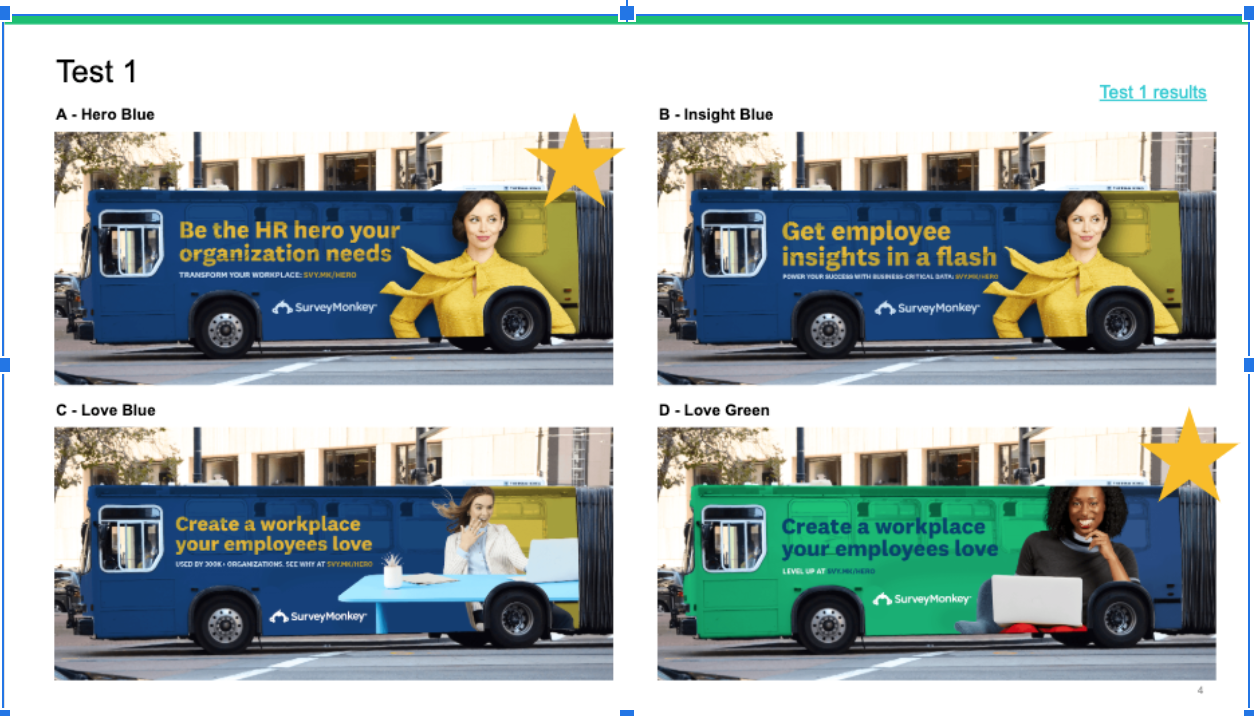As marketers, we are charged with driving disruptive business growth, which requires taking risks and making bold moves. This leaves marketing leaders in a quandary. The majority of CEOs consider CMOs to be first in the firing line if growth targets aren’t met, but at the same time, in-house marketers often take the heat for taking big swings at campaigns that miss the mark.
Marketing leaders are under constant pressure to continue innovating while at the same time knowing that a misstep could mean we are shown the door. I was acutely aware of this last year when SurveyMonkey set out to conduct our first real brand campaign.
Our goal was to get the word out that SurveyMonkey is for business. From previous market research, we knew our brand was well-known and beloved. During our 20 years in existence, tens of millions of people have come to know our product by taking surveys or sending them out on their own. But at the beginning of last year, too many professionals remained unaware of our enterprise capabilities. We wanted to re-introduce ourselves to business decision-makers and influencers, and build credibility with them as an enterprise-grade survey platform that helps organizations deliver excellence by turning feedback into action.
We decided that a multi-channel brand campaign could help us do just that. We were excited to be innovators—to do something we had never done before at our organization—but we wanted to innovate with impact. We had to make sure we were hitting the right people with the right message.
So we started with listening.
Perhaps unsurprising for a survey software company, we were hungry for data about what type of campaign would make the biggest impact. As a first step, we collected research showing that one of the top types of advertising people trust when making purchase decisions were ads in outdoor and public places. The top ad channel for recall? Out-of-Home advertising. All signs pointed toward a brand campaign that would extend SurveyMonkey’s message to our target audience as they went about their day.
Next, we conducted market research of our own using SurveyMonkey Market Research Solutions, to zero in on the messaging and visuals that resonated most with our target audience. We ran two concept tests. As our Creative Director Lara Belonogoff says, the first test was designed to make sure we were in the right neighborhood. The second was to tell us which house to buy.
For the first test, we were curious—would people be more drawn to ads that explained the benefits of SurveyMonkey to their organization, or the personal boost in confidence our customers feel when they are armed with survey data that helps them do their jobs better?
To test the idea, we created a handful of ads focused on these two themes and asked 350 business decision-makers how eye-catching, professional, interesting, and believable they found the ads to be. We also asked how useful they thought the product would be to their company.


The survey results showed that people gravitated toward two ads, both of which focused on the value SurveyMonkey users help drive for their organizations. People found these ads to be unique, believable, and appealing, and they also rated these ads as more persuasive than the others. One big difference did emerge between the top two options: people who weren’t familiar with SurveyMonkey loved the vibrant green color—a variable we were eager to explore further.
Based on the results of Test 1, we knew we were in the right neighborhood. We wanted to validate our conclusions, so we spun up a new test with fewer options.
Overall, among all respondents, “Hero Green” was consistently rated the highest for all attributes. As we suspected, the tagline around “being a hero” was perceived as bold. People connected to the idea that they could get a boost in personal confidence by using our product at work. And we saw signs that we were on the right track to drive real impact here: The “brand name recall” success rate jumped to 60% from 40% in test 1.
Armed with our market research, we took the idea to market in a big way. Our creative focused on three key personas: Marketing, HR, and Customer Success professionals. We showed all of them as “heroes” with copy like “Be the marketing hero your organization needs,” and used our eye-catching green to highlight how SurveyMonkey’s enterprise products can help you excel at work.
We ran this creative across a variety of out-of-home placements, including billboards and buses in the San Francisco Bay Area, wrapped cabs in London, and video ads running in Times Square in New York and at the Premium Lounge at the San Francisco airport. We created a suite of digital complements to augment the offline placements, including a custom landing page, video and static ads on desktop and mobile, an SEM campaign, and channels to activate our base, including email marketing, a social media strategy, and home page updates to match the out-of-home experience.
Brand campaigns can be hard to measure, but because we invested in both out-of-home and digital experiences, we were able to see how our perception shift was playing in the market. For example, we saw a 103% lift in brand search volume in the geographies where we ran our video campaign ads, indicating that people were drawn in by the creative and inspired to learn more―exactly as our surveys had predicted.
Working on this project demonstrated that when we can tap into feedback—from customers, employees, and the market—at scale, it’s a powerful asset that can help marketers innovate with impact, stand out in crowded markets, build trust, and take calculated risks.
We all participate in the Feedback Economy, and companies and leaders that incorporate feedback as part of their everyday processes will win in the market. Marketing leaders that operationalize feedback have the confidence to take measured risks. By actively listening to the people that matter most to their business CMOs and their teams can iterate quickly, and continuously optimize decisions and campaigns to drive disruptive business growth.



